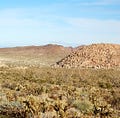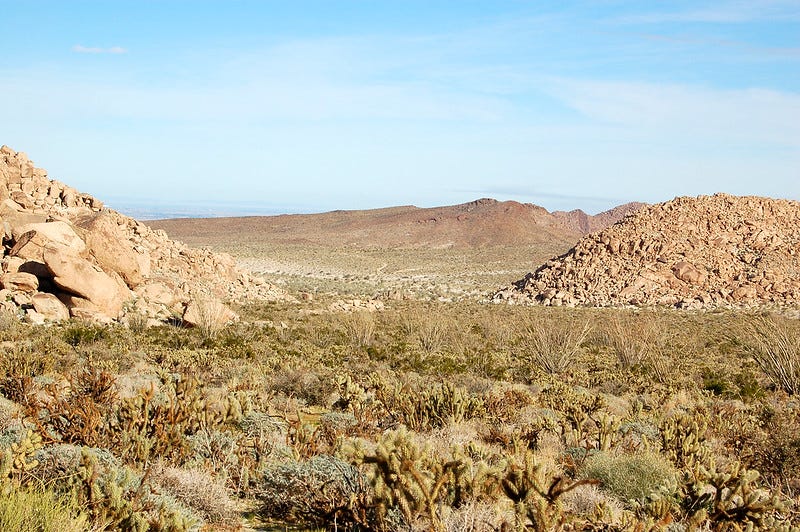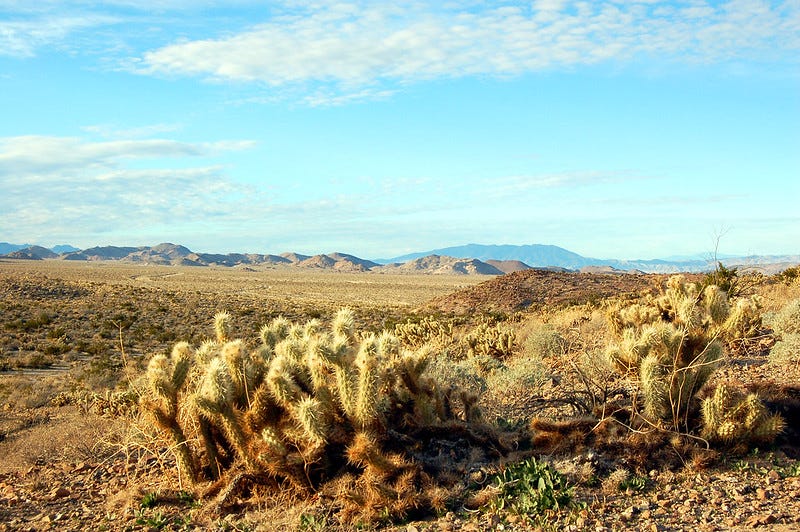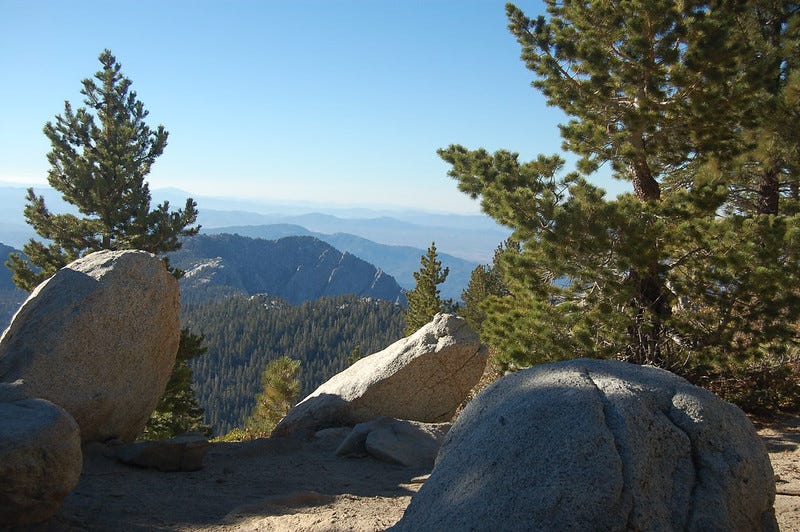On my first visit to the Anza-Borrego Desert, no one had to tell me it was a wilderness. That much seemed obvious at first sight — a glimpse of dry, tan hills in the distance as our car swooped around the curves of Interstate 8 on its plunge down the eastern scarp of the Jacumba Mountains. Beyond those distant hills was nothing but clear, luminous space, lit by the sun as it peeked through gaps in a receding band of clouds. Much was promised in that single glimpse, cut off by a bend of boulder-strewn canyon wall.
As we emerged onto the desert floor near the little town of Ocotillo, the hills we had seen from above grew into mountains, rising from the plains in striated reds, tans, browns, and whites. We turned north and then west onto a jeep trail and moved back toward the high mountains, regaining a thousand feet of the elevation we had just lost. The road crossed a bajada, a broad gravel-and-sand skirt created by the combined flood debris of many alluvial fans flowing together. Tall sprays of ocotillos and the twisted shapes of chollas lined the route as if greeting us.
It's hard to recapture how new the desert seemed back then. I didn’t know the name of the valley we were driving through or the names of the mountains on either side. To the north, more peaks rose up, thirty, forty miles distant, all nameless, all waiting to be explored. I remember thinking that the cacti and succulents we passed seemed aquatic, grotesque. I could imagine their many-armed branches waving to the rhythm of sea currents instead of a light breeze making its way down from the mountains.
That’s an early scene from my environmental history of the Anza-Borrego Desert Region, All the Wild and Lonely Places: Journeys in a Desert Landscape. The trip it describes took place in 1987, and the book came out in 2000, so it’s all a long time ago. That place and that experience are, in some sense, gone now. Oh, the state park where we camped is still there, along with the plants, animals, and other natural features it was designated to protect. But the feeling of the place, of vastness, of limitless space, that’s all gone, destroyed by the sight and the thrum of giant wind turbines marching down those same mountains and filling the valley below, right up to the state park boundary.
The Ocotillo Wind Project went in back in 2012, a year after my wife and I moved from San Diego to Michigan. I’ve only been back once, driving through Ocotillo at night, the flashing red lights atop the turbines like something from a sci-fi movie. I don’t think I could stand to re-visit that first desert campsite, even though at the time I thought both the place and the experience would be there forever.
To be clear, I’m as skeptical of the concept of wilderness as anyone. In fact, the whole premise of the book was that nothing in that original view could be considered “untouched by the hand of man.” The title is taken from a statement by Chief Francisco Patencio of the Cahuilla tribe: “All the wild and lonely places, the mountain springs are called now. They were not lonely or wild places in the past days—no. They were the homes of my people…” The rest of the narrative is about me adapting to that different, less colonial point of view.
And I also have to be clear that the effects of oil drilling and coal mining are far more devastating than those of wind turbines. But all of that can be true without changing the feeling I have for this place. Even just the knowledge of this vastly out-of-scale intrusion on this landscape hurt like hell. (It hurt even more for the local Kumeyaay and Quechan peoples, for whom this landscape is sacred.)
And this was just one scar of many over the last twenty years. Those scars add up to a deep environmental despair that forms one wellspring of my post-post-apocalyptic sci-fi novel, Ada’s Children. It was this despondency that drove me to leave the obviously unsustainable state of my birth, California, for the seemingly more sustainable, less disaster-prone state of Michigan, back in 2011. And that move came with its own kind of despair. As bucolic and, in the summer, fecund as Michigan can be, it lacks the dramatic landscapes of the West that fed my soul for so many years. It’s also darned cloudy a lot of the time.
That environmental despair is sometimes called solastalgia, in a term coined by the environmental philosopher Glenn Albrecht. My own solastalgia sprang from two somewhat intertwined sources — the oncoming Sixth Great Extinction and the (at the time) oncoming Climate Crisis as they were playing out in my home landscape. (I say “somewhat intertwined” because the extinction crisis would be happening whether or not we were releasing greenhouse gases. Extinction, at least on land, is caused mainly by habitat destruction and types of pollution other than CO2. Global heating only exacerbates the problem, shifting the home ranges of plants and animals faster than they can adapt or migrate.)
The despair first hit home on a solitary hike in the San Jacinto Mountains above Palm Springs. There I was, surrounded by one version of natural paradise, and all I could think was that this unique assemblage of pines and ferns and other seemingly out-of-place elements of boreal forest would soon be gone. This was partly because a similar range closer to home in San Diego, the Cuyamaca Mountains, had been largely destroyed in the Cedar Fire of 2003, and was showing few signs of coming back. It still hasn’t come back twenty years later, and it may never.
Another reason for my despondency surely had to do with the push-me-pull-you nature of environmentalism at the time, of which the Ocotillo Wind Project was just one example. Those were the Obama years, when large tracts of the California desert were being licensed to solar farms to fight climate change. The years when Governor Jerry Brown would say, in response to concerns about the destruction of habitat for species like the desert tortoise, “We’re going to give those tortoises plenty of shade.” I don’t think he ended the statement with “whether they like it or not,” but I heard it that way. These were also the years when a prominent climate change journalist claimed he was perfectly fine with cutting down the redwoods to accommodate solar farms. (And indeed, today, private forests of the northeast have fallen to the solar companies’ axes. In Europe, forests are felled under the guise of eco-friendly biofuel.)
In short, the intertwined but sometimes competing problems of habitat destruction and climate change had created a gordian knot, one that our politics and public policy had little hope of unraveling. (And this was way before our society here in the US was as polarized as it is now. Donald Trump’s questioning of Obama’s birth certificate just seemed like a harmless sideshow, or at least I remember it that way.) Species would go extinct, sea levels would rise. Extreme wildfires and storms would get worse. Refugees would flee formerly habitable lands and be met with — what? (The Saudis and the Texas Troopers are answering that question right now.)
Needless to say, the Trump years did nothing to alleviate my despondency, though they did give the deserts a bit of a reprieve from new solar farms. I spent that decade playing a lot of video games, writing fanfiction based on those videogames, and publishing one historical romance novel inspired by the Supreme Court’s marriage equality decision. (Good things do happen!) But by around 2019, I was ready to consider whether it would take an AI overlord to save us. And, as I pointed out last week, Horizon Zero Dawn provided a structural template for how to make a sci-fi novel out of my despondency. It still often seems like an AI might be our best and only hope, however fantastical.
That is, if humanity is worth saving at all. Every time an asteroid gets close to Earth, many respond with, “Might as well hit us and put us out of our misery,” and the like. Or, in the words of one commenter on a Rebecca Solnit piece about climate doomers, “Let humanity go. The planet doesn’t need us. Without us, it will recover.”
I’ve shared in that misanthropic mindset, at times. But I’m enough of a humanist to believe there’s something in humanity that’s worth saving, and likewise with all the myriad expressions of human culture. And that’s what my AI sets out to do in Ada’s Children, however imperfectly, at a time when environmental and political conditions on the planet have become far more extreme than they are now (or at least than they were back when I wrote the first draft).
I suppose it’s telling that, in order to justify an AI taking extreme measures, I had to amp up every trend leading toward catastrophe. In the year 2040 of my novel, the climate crisis has grown so dire that huge areas of the southern US (Houston, New Orleans, much of Florida) are under water; a US president has declared a national emergency and implements Richard Spencer’s racial homelands; and impending nuclear war between the US, Russia, and China threatens the entire planet. It’s both shocking and depressing that we’re so much closer to all three of those scenarios than we were just five years ago. Apart from the self-driving cars and sentient AI (neither of which may ever get here), I probably could have set the novel in 2029.
These days, I try to salve my solastalgia by following more hopeful prognosticators, like
and Rebecca Solnit; seeking out good environmental news, like the fact that we might be nearing peak carbon output, which means emissions will soon start decreasing; or focusing on the bald eagles that are making a great comeback in my adopted home state. Things can’t be all bad, right? If I squint, I can just make out the good news past the record high temperatures, the record low Antarctic sea ice, and the green lawns here in Michigan in February.And in both US politics and international diplomacy, there’s…well, crap, let’s not talk about that.
Is it any wonder I retreat into fantasy worlds like Ada’s Children and Horizon Zero Dawn?






Hey ol’ pal, I so enjoyed reading this and wished Dad were still here as I know he’d be as enthralled with your writing as I am😊. Your description of the Anza Borrego desert made me think of my first trip to Death Valley last spring…such beauty in such an inhospitable place. I’m looking forward to reading more!
Love and hugs, Lettie
I can relate to so much of this. I first found refuge in Anza Borrego in 2005–later than your 1980s experiences but before the wind farms went in. I still live in CA, but I am from Michigan and your thoughts about where to live resonate deeply. I have not yet been able to part with the West, despite living through wildfire, drought, and floods. Thank you for highlighting the complexities of alternative energy development—it’s so important to make clear that it’s not the win-win it’s often portrayed to be.